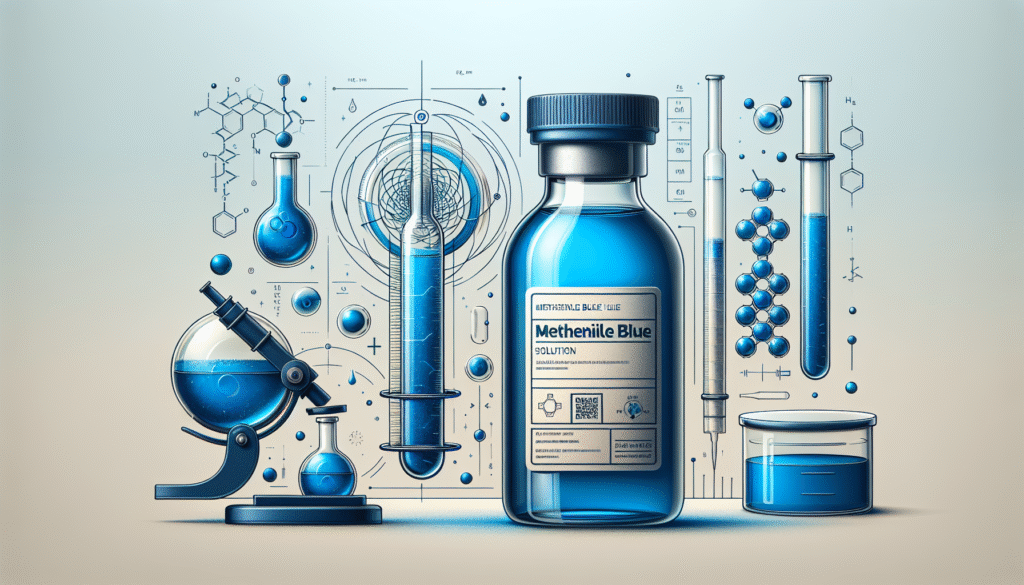
What if a single compound could transform the way you think about cellular processes, mental clarity, and even treatment for certain health conditions? Methylene Blue is that compound, a fascinating and multifaceted substance with a legacy that spans over a century of scientific inquiry.
Understanding Methylene Blue
Methylene Blue (MB) is a synthetic dye traditionally used in various applications, from staining biological specimens in laboratories to treating specific medical conditions. This compound possesses unique properties that make it a valuable tool in both research and medicine. Its chemical structure consists of a phenothiazine core, which contributes to its distinct properties and effects.
Historical Context
The history of Methylene Blue dates back to its synthesis in 1876 by Heinrich Caro, who intended it for use as a dye. It wasn’t long before researchers began to uncover its therapeutic potential—particularly in the treatment of malaria and as a urinary antiseptic. Its journey through medicine has been marked by both triumph and skepticism, yet it has steadfastly retained its relevance in contemporary scientific and medical discussions.
Chemical Properties
The chemical formula of Methylene Blue is C₁₆H₁₈ClN₃S, indicating its complexity. It is a phenothiazine derivative, which explains its vivid blue color and its ability to interact with biological systems. Due to its oxidation-reduction properties, Methylene Blue can exist in both oxidized and reduced forms, allowing it to participate in various biochemical pathways.
Formulations and Uses
Methylene Blue is available in multiple formulations, including solutions for intravenous (IV) administration, oral tablets, and topical applications. Its versatility extends beyond just a dye; here are some applications:
| Application | Description |
|---|---|
| Medical Treatments | Used to treat methemoglobinemia, a blood disorder, to restore normal oxygen transport. |
| Antimicrobial Agent | Exhibits antibacterial and antifungal properties, making it useful in treating infections. |
| Research Tool | Widely used in staining and visualizing biological tissues under microscopy. |
| Neuroprotective Effects | Emerging studies suggest benefits for neurodegenerative conditions, such as Alzheimer’s disease. |
Mechanism of Action
Understanding how Methylene Blue works is crucial to appreciating its potential benefits. Its primary actions stem from its ability to act as an electron donor, influencing redox reactions in cells. This unique characteristic allows it to participate in cellular respiration and energy production.
Cellular Respiration and Energy Production
Methylene Blue has been shown to enhance mitochondrial function, which plays a pivotal role in energy production. Mitochondria are the powerhouses of cells, generating adenosine triphosphate (ATP) through oxidative phosphorylation. Methylene Blue can facilitate this process in several ways:
-
Electron Transport Chain Modulation: MB can contribute electrons to the mitochondrial electron transport chain, potentially increasing ATP production, especially in cells under oxidative stress.
-
Reduction of Reactive Oxygen Species (ROS): By acting as an antioxidant, MB may reduce ROS levels, which are often damaging to cells and can lead to various diseases.
-
Improved Cellular Metabolism: Enhanced mitochondrial function can result in better overall cellular metabolism, thereby promoting overall health and vitality.
Neuroprotective Effects
Research has indicated that Methylene Blue may offer protection against neurodegeneration—an exciting area of ongoing investigation.
-
Alzheimer’s Disease: Some studies suggest that Methylene Blue may inhibit the formation of neurotoxic aggregates common in Alzheimer’s patients. By mitigating these toxic effects, MB may help preserve cognitive function.
-
Parkinson’s Disease: Evidence is accumulating that MB can protect dopaminergic neurons from apoptosis (programmed cell death) in animal models of Parkinson’s disease. Such findings warrant further exploration in clinical settings.

Clinical Applications
The spectrum of clinical applications for Methylene Blue is broad and continues to expand.
Treatment of Methemoglobinemia
Methylene Blue is well-established in the treatment of methemoglobinemia, a condition characterized by elevated levels of methemoglobin, which impairs the blood’s oxygen-carrying capacity. The mechanism by which MB acts in this scenario involves:
- Reduction of Methemoglobin: MB acts as an electron donor, facilitating the reduction of methemoglobin back to hemoglobin, thus restoring normal function.
Antimicrobial Properties
The antimicrobial effects of Methylene Blue extend to various pathogens, including bacteria and fungi.
-
Bacterial Infections: Research has shown MB’s effectiveness in treating urinary tract infections and certain skin infections, often in conjunction with antibiotics to enhance efficacy.
-
Fungal Infections: Some studies indicate that MB may possess antifungal properties, making it a candidate for treatment against stubborn fungal infections.
Dosage and Administration
When considering the therapeutic use of Methylene Blue, it is essential to look at the appropriate dosage and administration methods.
Recommended Dosage
- Methemoglobinemia Treatment: The typical dosage for adults is 1 to 2 mg/kg administered intravenously, with the option of repeating doses if necessary.
- Other Applications: Off-label uses may involve varying dosages, depending on the condition being treated and should always be guided by a healthcare professional.
Administration Routes
- Intravenous: Most common route for acute treatment of methemoglobinemia.
- Oral Tablets: Used in research studies focusing on its cognitive-enhancing properties.

Risks and Side Effects
While Methylene Blue has considerable therapeutic potential, it is important to acknowledge the possible risks and side effects associated with its use.
Common Side Effects
-
Urine Color Change: One of the most noticeable side effects is a temporary blue or green color change in urine, which is harmless but can be alarming.
-
Nausea and Vomiting: Some patients may experience gastrointestinal discomfort.
-
Headaches: Mild to moderate headaches can occur in some cases.
Serious Reactions
While rare, severe allergic reactions and interactions with specific medications (such as serotonin inhibitors) can occur. Always consult a healthcare professional before starting treatment with Methylene Blue, particularly for individuals taking other medications or with underlying health conditions.
Current Research and Future Directions
The interest in Methylene Blue is growing, particularly in areas of neuroprotection and cellular metabolism. Ongoing research seeks to clarify its efficacy and determine the best therapeutic protocols.
Cognitive Enhancement
Recent studies have investigated the potential of Methylene Blue to enhance cognitive performance in healthy individuals. Findings suggest that low doses could improve memory and attention, opening avenues for its use in treating age-related cognitive decline.
Neurodegenerative Diseases
As research expands, the focus on Methylene Blue as a potential treatment for neurodegenerative diseases grows. The hope is to develop effective protocols for its application in conditions like Alzheimer’s and Parkinson’s Disease.

Conclusion
Methylene Blue stands at the crossroads of history and modern medicine, showcasing a remarkable range of applications from its dye origins to its current role in treating various health conditions. Its methodological action on cellular respiration, neuroprotection, and antimicrobial activity underscores its potential as a powerful therapeutic agent.
As research continues to evolve, the promise of Methylene Blue may one day lead to groundbreaking treatments for diseases that currently elude effective management strategies. Understanding its mechanisms, benefits, and associated risks is essential to fully harnessing this compound’s potential in both clinical and research settings. Always consult with a healthcare professional before considering Methylene Blue for any therapeutic use, ensuring a safe and informed approach to its benefits and applications.